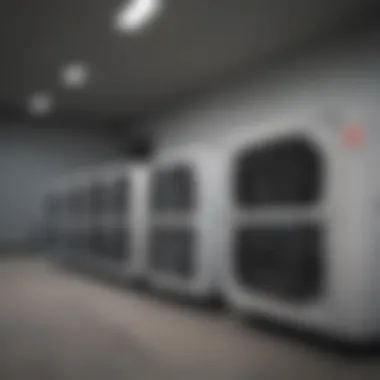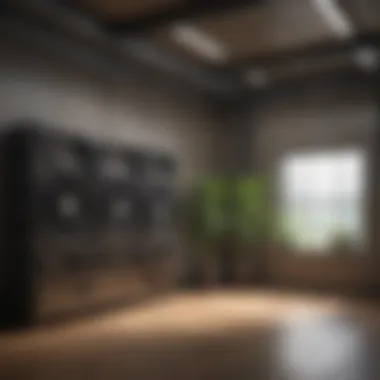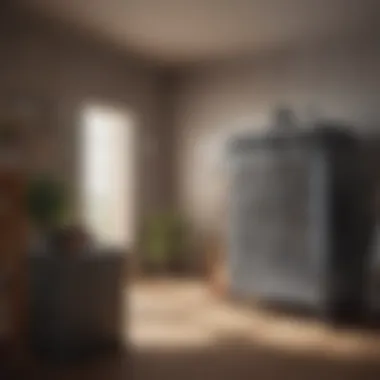Understanding Central Air Conditioning Installation Costs


Intro
Installing central air conditioning is not just about comfort; it is also a matter of making a significant financial decision that affects your home and lifestyle. This investment involves understanding myriad factors that contribute to the total costs. Key considerations include the type of unit, the specifics of installation, labor fees, ongoing maintenance, and potential hidden costs. Being well-informed can help homeowners approach this decision strategically, ensuring they choose an option that meets their needs without overspending.
Key Factors Influencing Costs
Understanding the costs associated with central air conditioning requires an analysis of several key components. These can be divided into two primary categories: initial costs and ongoing expenses.
Initial Costs
The initial costs encompass all expenses incurred before the air conditioning system is operational. This includes:
- Unit Selection: The choice of systems such as single-stage, multi-stage, or variable-speed units significantly influences the total cost. Each type offers different efficiencies and price points.
- Installation Complexity: Installation specifics can vary, impacting labor and materials costs. Simple installations may be less expensive than those that need additional ductwork or electrical work.
- Labor Fees: Hiring qualified professionals is essential. The hourly rates can fluctuate based on geographical location and the contractor's expertise.
Ongoing Expenses
Once the system is installed, ongoing expenses come into play. Homeowners need to budget for:
- Utilities: Energy consumption will vary depending on the efficiency of the system. High-efficiency models can lead to reduced energy costs.
- Maintenance: Regular maintenance is necessary to ensure optimal performance. Homeowners should anticipate costs for tune-ups and filter replacements.
- Repairs: Unexpected failures can lead to repair costs. Investing in warranties or service plans may mitigate these risks.
Important Note: Understanding the full scope of costs associated with central air conditioning comes down to recognizing both immediate and long-term factors.
The End
By examining the various elements influencing the costs of central air conditioning, homeowners can equip themselves with the knowledge required to make informed choices. It is essential to balance features, installation specifics, and ongoing maintenance in the decision-making process. Such careful consideration of costs can lead to a more comfortable and energy-efficient home.
Prolusion to Central Air Conditioning Systems
Installing a central air conditioning system is central to achieving comfort in a home, especially in regions with extreme temperatures. Understanding the specific elements that inform these systems can significantly impact the decisions made. Key reasons behind this importance include aspects such as energy efficiency, overall costs, and long-term comfort benefits for homeowners. This section will lay the groundwork for a thorough examination of central air conditioning systems, analyzing their definition, types, and how they serve various needs in residential settings.
Definition and Importance
Central air conditioning refers to a system designed to cool multiple rooms or an entire house from a single unit. This system uses a network of ducts to distribute cooled air throughout the residence. One crucial aspect is its ability to maintain a consistent temperature across all spaces, adding to the comfort level of the home.
Homes using central air often experience better air quality. This is because these systems can include air filtration that removes dust, allergens, and other debris from indoor air. Considering air quality is essential, especially for those with allergies or respiratory issues.
Types of Central Air Conditioning Systems
Split Systems
One of the most common types is the split system. It consists of an outdoor compressor unit and an indoor air handler. The outdoor unit dissipates heat, while the indoor unit circulates cool air. This separation allows for effective cooling without excessive noise indoors. A key characteristic is its flexibility. Homeowners can choose to cool specific zones, which can save on energy costs when only certain rooms are used frequently.
The split system is a beneficial choice mainly due to its efficiency. Many units now come with high SEER (Seasonal Energy Efficiency Ratio) ratings, offering significant savings in energy bills. However, its installation can be complex, demanding a thoughtful approach to ductwork and precise placements.
Packaged Systems
Packaged systems offer a different approach. These systems house all components in one single unit, typically installed on a roof or a concrete slab. This setup allows for easier installation, particularly in homes lacking space for individual units. One key advantage is that it often requires less maintenance since the entire system is within a single compartment.
However, while packaged systems may be simpler to install, their efficiency can vary. Some models may not offer the same energy-saving potential as split systems depending on the unit chosen and local climate conditions.
Heat Pumps


Heat pumps function as two-in-one units, providing both heating and cooling. They extract heat from the outside air and transfer it indoors in winter, while the process reverses in summer. The ability to serve dual purposes makes heat pumps a flexible choice for various home environments.
This type of system is particularly advantageous in moderate climates, where temperatures do not reach extreme highs or lows. However, in extreme cold, their efficiency may decrease compared to other system types, necessitating additional heating sources.
Understanding these various systems is essential in exploring the costs associated with installation. Each type has its own set of benefits and can impact not just the initial outlay but also future energy expenses and maintenance requirements.
Factors Influencing Installation Cost
Type of Equipment
High-Efficiency Units
High-efficiency units stand out due to their ability to offer significant energy savings. These systems typically carry a higher upfront price due to advanced technology, but they operate with better energy ratings, like SEER (Seasonal Energy Efficiency Ratio). The key characteristic of high-efficiency units is their environment-friendly design, which not only reduces carbon footprints but also lowers utility bills over time.
The unique feature of these units is their variable speed compressor that adjusts cooling output based on demand. This means they do not waste energy cooling spaces unnecessarily, making them a beneficial choice for energy-conscious homeowners. However, it is essential to weigh the initial investment against potential savings in energy costs and rebates available for energy-efficient systems.
Standard Units
On the other end, standard units tend to be more affordable at the outset. These systems are easier to install and typically require lower investment in terms of equipment costs. The main characteristic that appeals to many homeowners is their straightforward design and ease of replacement.
A distinctive feature of standard units is their fixed-speed compressor. While these systems are reliable, they may lead to higher energy consumption during peak demand as they do not adjust based on the cooling needs of the home. Thus, the disadvantages include higher energy bills over time and less environmental efficiency compared to high-efficiency options. Homeowners with limited upfront budget may lean towards standard units, but must be aware of the potential for increased long-term costs.
Home Size and Layout
The size and layout of a home significantly affect the installation cost of central air conditioning systems. Larger homes need more extensive equipment and complex ductwork, which leads to higher costs. The layout of the home plays a role in determining the efficiency of the cooling system. Homes with open floor plans may allow for more effective cooling, while those with many divided spaces can create challenges that increase installation costs.
Local Climate Considerations
Local climate conditions must also be taken into account when assessing installation costs. For instance, homes in hotter regions may benefit from more powerful units or additional modifications to ensure proper cooling. Seasonal variations can impact energy efficiency and unit performance, making it essential to choose a system that can handle local temperatures effectively. This climate interaction with the system can greatly influence both initial costs and ongoing expenses.
Installation Costs Breakdown
Understanding the costs associated with installing central air conditioning systems is vital for homeowners contemplating this substantial investment. The installation costs represent a significant portion of the total expenditure and encompass various components that must be carefully analyzed. By dissecting these costs, you will gain valuable insight into both expected expenses and possible future financial implications. This breakdown not only aids in budgeting but also prepares homeowners for the specific financial commitments involved in maintaining comfort.
Equipment Purchase
The crucial first step in the installation process is the purchase of the air conditioning unit itself. The cost of the equipment varies widely based on factors such as size, brand, and energy efficiency. High-efficiency units, while more expensive upfront, often result in lower energy bills over time. Standard units may have an attractively lower initial cost but could lead to higher ongoing expenses.
When purchasing equipment, it is essential to consider the following:
- Size of Unit: Selecting the appropriate size affects cooling efficiency. A unit that is too small cannot effectively cool a home, while an oversized unit may lead to unnecessary energy consumption.
- Brand Reputation: Investing in established brands like Trane or Lennox may provide better long-term reliability than lesser-known options.
- Energy Efficiency Ratings: Look for models with a high Seasonal Energy Efficiency Ratio (SEER), as these are designed to be more efficient and can significantly reduce utility bills.
Evaluating both the equipment cost and its long-term value is critical for informed decision-making.
Labor Charges
Installation labor charges represent a significant portion of the overall cost. These charges depend on the complexity of the installation, local labor rates, and the contractor's experience. An important aspect to keep in mind is that cheaper labor is not always the best choice. Hiring qualified and insured professionals can save homeowners from potential future problems.
When considering labor costs, here are vital factors to assess:
- Installation Complexity: More complex setups, particularly in homes without existing ductwork, will increase labor fees. A straightforward installation will cost less than a project involving significant modifications.
- Local Labor Rates: Prices for labor vary based on geographical location and market conditions. It is beneficial to gather estimates from multiple contractors to understand the local rate range.
- Experience of the Installer: Well-reviewed contractors may charge higher rates but often provide better service and expertise.
Collecting multiple quotes and referencing past work can aid in selecting the right contractor.
Permits and Inspections


Permits and inspections are often overlooked but are necessary components of the installation process. Local governments establish regulations to ensure that installations are safe and up to code. These requirements necessitate permits, which often incur additional costs.
It is important to remember the following about permits and inspections:
- Cost Variation by Area: Different regions have varying permit costs. Always check local municipality regulations regarding permitted work.
- Inspection Requirements: Many places require final inspections after installation to certify compliance with safety standards. This may not only add to costs but also influence the timeline of the installation project.
- Potential for Future Issues: Skipping permits may lead to problems down the line, including fines or the inability to sell the property in the future.
By understanding the significance of all associated costs, homeowners can prevent misunderstandings and financial strain during the installation process.
Ongoing Expenses
Understanding ongoing expenses associated with central air conditioning is crucial. Installation costs are just the beginning. Homeowners need to budget for long-term expenses, which can impact their financial planning significantly.
Energy Consumption
Energy consumption is a primary ongoing expense. Central air conditioning systems consume a considerable amount of electricity, especially during peak summer months. Efficiency ratings, such as SEER (Seasonal Energy Efficiency Ratio), influence how much energy a unit will use. Higher efficiency units tend to cost more upfront but can save money in the long run through reduced energy bills. For example, a system with a SEER rating of 16 is generally more efficient than one rated at 13.
Regular monitoring of energy consumption can help homeowners manage costs effectively. Utilizing smart thermostats can optimize energy usage, allowing for programming based on daily schedules. Homeowners should also consider conducting an energy audit to spot inefficiencies in their homes.
Maintenance Costs
Maintenance costs are another critical consideration. Regular maintenance is necessary to ensure the system operates efficiently. This can include changing filters, cleaning coils, and inspecting ducts. Typically, homeowners should expect to spend about $150 to $500 annually for preventive maintenance.
Routine maintenance benefits include:
- Improved system efficiency
- Extended lifespan of the unit
- Reduced chances of costly repairs
Skipping maintenance can lead to larger repairs in the future, which can become expensive due to the complexity of air conditioning systems. Regular check-ups from certified technicians can help avoid these situations.
Repairs and Replacement
Finally, repairs and replacements can significantly influence ongoing costs. Air conditioning systems, like any appliance, experience wear over time. Components such as compressors, fans, or capacitors may need repairs. On average, homeowners may face repair bills ranging from $100 to $2,000 depending on the issue.
When it comes to replacement, it’s essential to consider the age of the unit. Generally, air conditioning systems last around 10 to 15 years. After this period, efficiency lowers, and replacement might be more cost-effective than continual repairs. Investing in a new unit may also come with updated technology that provides better energy efficiency and reliability, thus lowering long-term costs.
"Effective budgeting for ongoing expenses ensures homeowners maintain a balance between comfort and financial responsibility."
In summary, ongoing expenses for central air conditioning include energy consumption, maintenance, and potential repairs or replacements. Being aware of these costs enables homeowners to make informed decisions and plan effectively for their home's cooling needs.
Finding and Evaluating Contractors
Finding the right contractor for central air conditioning installation is a critical aspect of ensuring the system operates efficiently and effectively. In this section, we will explore the importance of choosing a reliable contractor. This decision affects both the installation's quality and the long-term performance of the air conditioning units. Failing to select the right contractor can lead to inflated costs and complications down the line.
Researching Experience and Reputation
When searching for a contractor, it is vital to consider their experience and reputation within the industry. A contractor with years in the field likely has the necessary skills to tackle various installation challenges. Look for reviews or testimonials from previous clients to gauge satisfaction levels. Websites like reddit.com and facebook.com can be excellent resources for finding firsthand accounts of contractor experiences.
Additionally, verify if the contractor has any certifications from reputable organizations. Certifications can indicate an adherence to standards, assuring homeowners that the contractor is knowledgeable about installation and maintenance practices. Experience helps, but reputation solidifies it. Ask for references and follow up with them to discuss both successes and challenges of their installations.
Getting Multiple Quotes
Getting multiple quotes is a wise strategy to understand the cost landscape and identify potential red flags. When you gather estimates from different contractors, ensure they follow similar parameters for the quotes. This uniformity will give you a clearer picture of what to expect regarding total installation costs.


Compare not only the overall price but also the details of what each quote includes. For example, one contractor may offer a higher quote but include superior warranties or equipment upgrades. This information can help you weigh the value of each quote against the cost. Evaluate the transparency of each contractor. Clear communication about pricing and services often hints at future professionalism.
Understanding Warranty Options
Warranties play an essential role in the overall cost of central air conditioning systems. When selecting a contractor, inquire about the warranty offered on both the equipment and the installation services. A strong warranty can shield homeowners from significant repair costs and offer peace of mind should issues arise unexpectedly.
Evaluate the duration of the warranties and what they specifically cover. Some contractors may provide limited warranties, while others may offer extended options. Make sure to ask which components are included and whether labor is part of the coverage. Understanding these aspects can be crucial when it comes time for any repairs, ultimately affecting your costs dramatically over time.
Potential Additional Costs
When installing a central air conditioning system, many homeowners focus primarily on the equipment and labor costs. However, it is equally important to consider potential additional costs that can significantly impact the overall budget. Understanding these extra expenses can help in creating a more accurate financial plan and avoid surprises in the future.
Ductwork Modifications
In many cases, existing ductwork may need modifications to accommodate a new central air conditioning system. This is especially true when upgrading to a more powerful or different type of system. Adjustments might include sealing leaks, insulating ducts, or even replacing old duct sections that are no longer efficient.
Considerations for ductwork modifications include:
- Age of existing ducts: Older ducts might not support the efficiency of new units.
- Size and layout: Ducts need to be tailored to the dimensions of the home and the cooling requirements.
- Material quality: Some materials are more prone to wear and can lead to air loss.
Investing in quality ductwork modifications can lead to better energy efficiency, resulting in lower utility bills over time.
Zoning Systems
Zoning systems offer an effective way to control the temperatures in different areas of a home. They use multiple thermostats and dampers within the ductwork to direct airflow where needed. While installing a zoning system incurs initial costs, it can provide benefits such as comfort management and energy savings.
Key points regarding zoning systems include:
- Increased comfort: Different rooms can maintain different temperatures based on usage.
- Energy efficiency: By cooling only the spaces you inhabit, energy waste is minimized.
- Installation complexity: Zoning systems do complicate installation and may require additional ductwork or electrical upgrades.
These systems appeal to homeowners seeking a tailored cooling experience.
Upgrades to Electrical Systems
A new central air system might demand more power than older models. As such, upgrades to the electrical system might be necessary to ensure that the unit operates safely and efficiently. This can include:
- Upgrading the circuit breaker: A higher capacity may be needed for the new unit.
- Wiring upgrades: To handle the electrical load adequately and reduce fire risks.
- Installation of dedicated circuits: Helping to isolate the air conditioning system from other household electrical demands.
Completing electrical upgrades not only improves the performance of the A/C system but also enhances overall electrical safety within the home.
Overall, considering these potential additional costs is essential in developing a comprehensive budget for your central air conditioning installation. Understanding the implications of ductwork modifications, zoning systems, and electrical upgrades can inform a more strategic approach to your home's cooling needs.
Epilogue and Considerations
In the context of installing central air conditioning, the Conclusion and Considerations section serves as a critical synthesis of the key points discussed throughout the article. It is essential to reflect on the substantial investment you are making in your home. Understanding the various costs associated with installation and ongoing maintenance can help ensure that the decision aligns with your long-term comfort and financial goals.
Assessing Long-Term Value
When evaluating the long-term value of central air conditioning, one must consider multiple factors. First, the initial outlay should be compared against potential savings on energy bills. High-efficiency units, for instance, often come with a higher purchase price but are known for significantly reduced operational costs.
Additionally, consider how central air can enhance your property's resale value. Homes with reliable climate control systems are often more appealing to potential buyers. Statistics suggest that homes equipped with good air conditioning systems can sell for more than those without. Furthermore, a well-maintained air conditioning system can minimize the risk of unexpected breakdowns, which could result in costly repairs down the line.
Making an Informed Decision
Making informed decisions requires careful evaluation of all available information. Homeowners should take the time to understand the various components of costs discussed in earlier sections. This understanding allows you to weigh immediate expenses against potential long-term benefits more accurately.
Gather multiple bids from contractors and ask detailed questions regarding what is included in their estimates. This diligence can help avoid hidden costs and ensure you get the best value for your investment. Consider also how different models and types of air conditioning systems may fit your specific needs. Each has unique attributes that can affect performance, efficiency, and, ultimately, your comfort.



